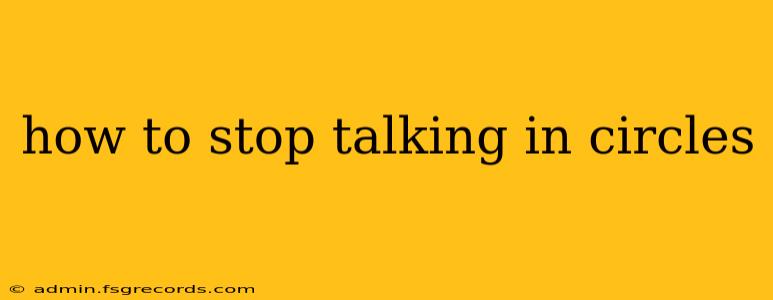Do you ever feel like you're going around in circles during conversations? You start a point, get sidetracked, and end up back where you began, leaving your listener confused and frustrated? This frustrating communication pattern, often called "talking in circles," can damage relationships, hinder productivity, and create misunderstandings. But don't worry, it's a common problem with a solvable solution. This guide will equip you with practical strategies to break free from circular conversations and communicate with clarity and impact.
Understanding Why We Talk in Circles
Before we dive into solutions, it's crucial to understand the root causes of this communication style. Several factors can contribute to talking in circles:
- Lack of a Clear Objective: Often, we start conversations without a defined goal. Without a clear endpoint in mind, it's easy to wander off track and repeat ourselves.
- Fear of Directness: Sometimes, we avoid stating our needs or opinions directly, leading to roundabout explanations that confuse the listener.
- Poor Organization of Thoughts: A jumbled thought process can manifest as a disorganized conversation, filled with tangents and repetitions.
- Overthinking: Excessive analysis and second-guessing can disrupt the flow of conversation, leading to a circular pattern.
- Nervousness or Anxiety: In stressful situations, our communication can become muddled and less coherent.
Practical Strategies to Break the Cycle
Now that we understand the underlying issues, let's explore effective techniques to improve communication and stop talking in circles:
1. Define Your Objective Before You Speak
Before engaging in any conversation, especially important ones, take a moment to clarify your goal. What do you want to achieve? What message do you want to convey? Having a clear objective will act as a roadmap, keeping you focused and preventing tangents.
2. Structure Your Thoughts
Before speaking, mentally organize your points. A simple outline can make a world of difference. Consider using the following structure:
- Main Point: State your central idea concisely.
- Supporting Evidence: Provide specific examples or details to support your point.
- Conclusion: Briefly summarize your main point and desired outcome.
3. Practice Active Listening
Active listening involves fully concentrating on the speaker, understanding their message, responding thoughtfully, and remembering what was said. This crucial skill prevents misunderstandings and helps keep the conversation on track. Pay attention to both verbal and nonverbal cues.
4. Use Concise Language
Avoid unnecessary words or jargon. Get straight to the point and use simple, direct language. Replace lengthy explanations with clear, concise statements.
5. Embrace Pauses and Breaks
Don't be afraid to pause during a conversation to collect your thoughts or allow the other person to respond. Pauses prevent rambling and allow for a more natural flow.
6. Ask Clarifying Questions
If you're unsure about something, don't hesitate to ask clarifying questions. This ensures you understand the other person's perspective and prevents misunderstandings that can lead to circular conversations.
7. Seek Feedback
Ask trusted friends, family members, or colleagues for feedback on your communication style. Their honest observations can help you identify areas for improvement.
8. Practice Mindfulness
Mindfulness techniques can help you stay present and focused during conversations, reducing the likelihood of getting sidetracked. Practice deep breathing or meditation to improve your focus and awareness.
Conclusion: Clear Communication is Achievable
Talking in circles isn't an insurmountable obstacle. By implementing these strategies and practicing consistently, you can improve your communication skills, convey your message effectively, and enjoy more productive and fulfilling conversations. Remember, clear communication is a skill that can be learned and refined over time. With patience and effort, you can break free from circular conversations and achieve clarity in your interactions.

